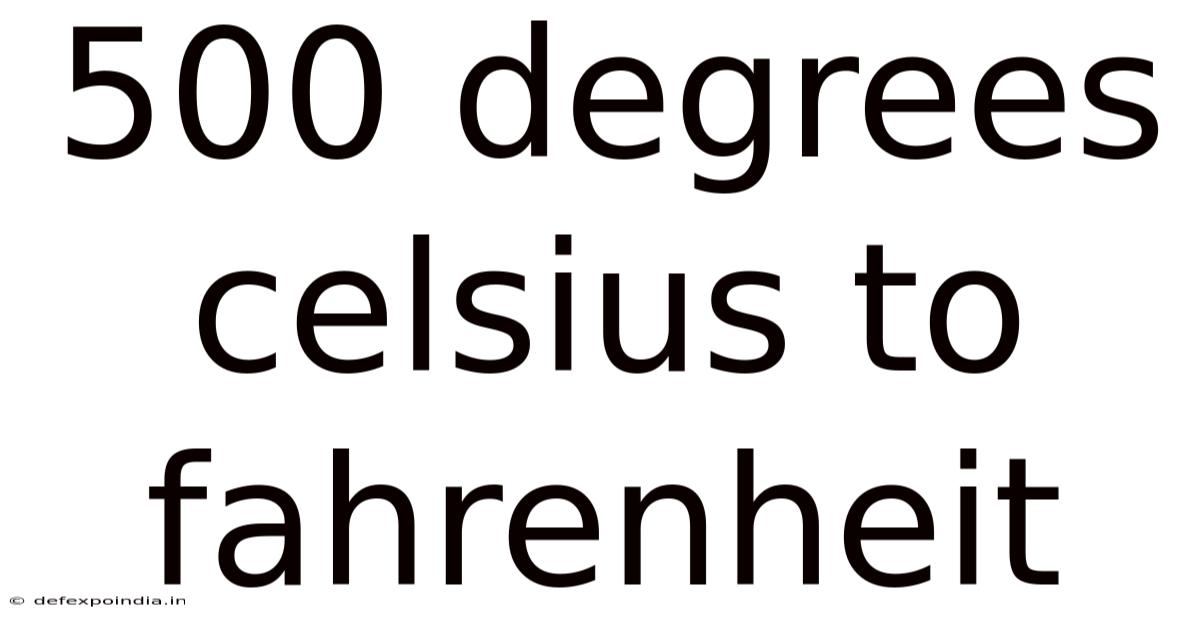500 Degrees Celsius To Fahrenheit
defexpoindia
Sep 19, 2025 · 5 min read

Table of Contents
Converting 500 Degrees Celsius to Fahrenheit: A Comprehensive Guide
Converting between Celsius and Fahrenheit is a common task in various fields, from cooking and everyday life to scientific research and engineering. Understanding this conversion is crucial for anyone working with temperature measurements. This article provides a thorough explanation of how to convert 500 degrees Celsius to Fahrenheit, delving into the underlying formula, practical applications, and addressing frequently asked questions. We'll also explore the significance of this specific temperature and its implications across different contexts.
Introduction: Understanding Temperature Scales
Before diving into the conversion, let's briefly review the two most commonly used temperature scales: Celsius (°C) and Fahrenheit (°F). Celsius, also known as the centigrade scale, is part of the International System of Units (SI) and is widely used globally. It defines the freezing point of water at 0°C and the boiling point at 100°C at standard atmospheric pressure. Fahrenheit (°F), prevalent primarily in the United States, defines the freezing point of water at 32°F and the boiling point at 212°F. The difference in these scales stems from their historical development and different reference points.
The Conversion Formula: Celsius to Fahrenheit
The conversion from Celsius to Fahrenheit utilizes a simple yet precise formula:
°F = (°C × 9/5) + 32
Where:
- °F represents the temperature in Fahrenheit
- °C represents the temperature in Celsius
This formula accounts for the different scales and their respective reference points. The factor 9/5 adjusts the scale difference, and adding 32 shifts the zero point to align with the Fahrenheit scale's freezing point of water.
Calculating 500 Degrees Celsius to Fahrenheit
Now, let's apply the formula to convert 500°C to °F:
°F = (500°C × 9/5) + 32
°F = (900) + 32
°F = 932
Therefore, 500 degrees Celsius is equal to 932 degrees Fahrenheit.
Practical Applications of 500°C (932°F)
A temperature of 500°C (932°F) represents a significantly high level of heat. Its applications span diverse industries and processes:
-
Metallurgy and Metalworking: This temperature range is crucial in various metallurgical processes like forging, heat treating, and melting certain metals. Many metals reach their melting point or undergo significant phase changes around this temperature. For example, lead melts at around 327°C, while aluminum melts at 660°C. Many alloys and specialized metalworking techniques require precise temperature control within this range.
-
Ceramics and Glass Manufacturing: High temperatures are essential in the manufacturing of ceramics and glass. 500°C is often used in the firing and shaping of ceramic products, ensuring proper hardening and desired properties. Glass production also relies on high-temperature furnaces operating within this range or even higher.
-
Industrial Furnaces and Kilns: Various industrial processes utilize high-temperature furnaces and kilns that reach and maintain temperatures around 500°C. This includes applications in cement production, chemical processing, and waste incineration. Precise temperature control in these furnaces is crucial for efficiency and safety.
-
High-Temperature Chemistry and Experiments: Many chemical reactions and experiments require controlled high temperatures. Researchers and scientists utilize furnaces and specialized equipment to achieve and maintain temperatures of 500°C for specific chemical processes or material studies.
Scientific Explanation of High Temperatures
At 500°C, the kinetic energy of molecules is significantly high. This increased energy results in increased molecular vibration and movement. In solids, this can lead to structural changes, phase transitions, or even melting. In gases, the increased kinetic energy translates to higher pressure and potentially increased reaction rates. Understanding the behavior of materials at these temperatures is vital in various scientific fields.
Safety Precautions at High Temperatures
Working with temperatures around 500°C presents significant safety risks. Proper personal protective equipment (PPE) is essential, including heat-resistant gloves, clothing, eye protection, and respiratory protection. Proper handling procedures and safety protocols should always be followed to prevent burns, fires, or other accidents.
Frequently Asked Questions (FAQs)
-
Q: Is 500°C hot enough to melt steel? A: No, the melting point of steel varies depending on its composition, but it typically falls within the range of 1370°C to 1510°C. 500°C is considerably lower.
-
Q: What are some common materials that can withstand 500°C? A: Several high-temperature materials can withstand 500°C, including certain types of ceramics, high-temperature alloys (like Inconel), and specialized refractories.
-
Q: How accurate is the conversion formula? A: The formula is highly accurate for most practical purposes. However, minute discrepancies might occur due to factors such as atmospheric pressure and the specific measuring instruments used.
-
Q: Are there alternative methods for converting Celsius to Fahrenheit? A: While the formula is the most precise method, online converters and specialized calculators can also perform the conversion quickly and accurately.
-
Q: Can I use this conversion for other temperatures? A: Yes, absolutely! The formula (°F = (°C × 9/5) + 32) works for any temperature in Celsius, regardless of whether it's high, low, or even below freezing.
Conclusion: The Significance of Temperature Conversion
The ability to convert between Celsius and Fahrenheit is a fundamental skill with broad applicability. Understanding the process, the underlying formula, and the implications of specific temperatures is crucial in numerous fields. The conversion of 500°C to 932°F highlights the significance of this temperature range in various industrial and scientific contexts, underscoring the importance of accurate temperature measurement and control for safety and efficiency. Remember always to prioritize safety when working with high temperatures. Further research into specific applications of this temperature range will provide a deeper understanding of its impact across different disciplines.
Latest Posts
Related Post
Thank you for visiting our website which covers about 500 Degrees Celsius To Fahrenheit . We hope the information provided has been useful to you. Feel free to contact us if you have any questions or need further assistance. See you next time and don't miss to bookmark.